Instagram's Buyout: How Does It Measure Up?
Instagram’s billion-dollar sale to Facebook raised eyebrows yesterday, renewing cries of a new bubble. But relative to other major acquisitions of the past, how does it measure up?
I crunched the numbers, pulling together data from a selection of 30 notable internet acquisitions over the last ten years, from Broadcast.com to OMGPop, to see if the Facebook/Instagram acquisition was as crazy as everyone thinks. (I left out companies without public purchase prices or user stats.)
The spreadsheet below captures the acquisition date, dollar amounts, and ballpark counts of the users and employees at the time of acquisition. Be warned: any of these numbers are very rough, cobbled together from Internet Archive searches, old news articles, Quora answers, and tech blogs. If you have more accurate information, please leave a comment and I’ll fix it.
Download the spreadsheet or view it on Google Docs.
Cost Per User
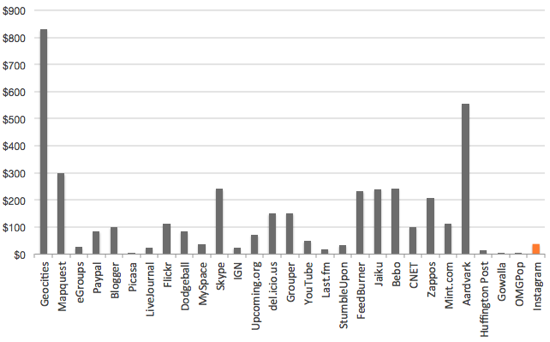
When a startup’s acquired, they’re purchased for any combination of the technology, talent, or the user base.
If we look strictly at the acquisition cost per user, Facebook got a relative deal with the Instagram purchase, paying roughly $37 for each of Instagram’s 27 million users. (The median cost across all the acquisitions is about $92 per user.)
Compare that to acquisitions like Aardvark ($555/user) or Jaiku ($240/user), and you can systematically see which were likely technology or talent hires. The glaring exception is Yahoo’s famous purchase of Mark Cuban’s Broadcast.com in 1999, which paid nearly $10,000 for each of their 520,000 monthly active users, ten times any other startup. (Broadcast.com skewed the chart so much, I had to leave it off.)
Cost Per Employee
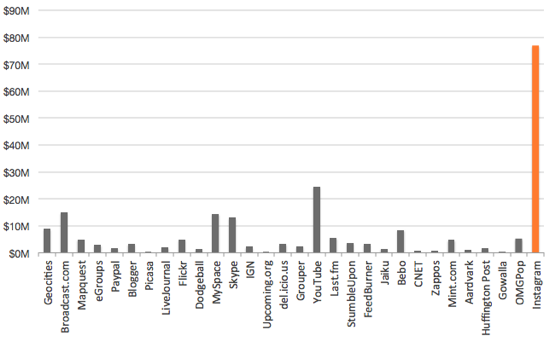
But if you look at the payout per employee, Instagram is completely off the charts. If split equally, each of Instagram’s 13 employees would make nearly $77 million. The nearest runner-up is YouTube, with a paltry $24M for its 2006-era staff of 67. Skype, Broadcast.com, and Myspace all top the charts. The median? About $3 million.
Some would point to this as a sign of a bubble, but I think it’s more likely it just reflects the incredible scalability of modern app architectures. Using cloud services, failover, and solid monitoring, Instagram can quickly scale up to support a million new users overnight with very little additional engineering effort.
The User-to-Employee Ratio
Instagram’s numbers are exactly what you’d want to see in a social network — high user counts with the lowest number of employees. This ratio is a measure of your efficiency, and it’s no surprise that Instagram comes out on top here, with a ratio of one employee for every 2.07 million users.
The second highest user-to-employee ratio is OMGPOP, famous for developing Draw Something, the fastest-growing mobile app in history. With only one employee for every 875,000 users, they were able to scale to 50 million users within 50 days.
On the other end of the scale are the short-lived Q&A service Aardvark, with one employee for every 1,800 users, and customer-service giant Zappos with one employee for every 3,400 users.
More than anything, the app ecosystem rewards efficiency; your ability to massively scale with very little engineering effort. I’m guessing these ridiculously lean startups with huge exits aren’t a freak occurrence. We’ll see more of them as the rest of the world catches up, and learns how to do more with less.
Methodology
All figures are at the time of acquisition, and I favored active user counts over total registered users for calculating acquisition cost per year.
Thanks to Tristan Louis for providing some of the rumored numbers.
Update
I originally published this yesterday on Wired, under a different headline and revised lede from my editor. To be clear, I don’t know if we’re in a bubble or not. My only point is that, relative to other acquisitions, the per-user cost for Instagram isn’t insane. Union Square Ventures’ Albert Wenger added some additional thoughts, noting that the per-user costs should be discounted as the userbase grows.
Many Wired commenters complained I was wrong because Instagram has no revenue. In 2006, YouTube had 34M users, zero revenue, and were bleeding $1M/month for bandwidth alone. Was Google crazy to buy them, too?
Anyway, it was a good excuse to collect all of this data in a spreadsheet for the first time. I went looking, and couldn’t find the numbers available in one place anywhere. Hope you liked it.
The Fun Pass Is An Awesome Deal
At $2, the Fun Pass is an awesome deal. At $1.50? Unbeatable.
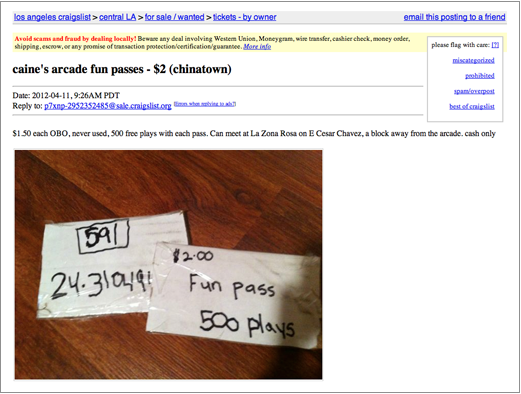
I guess Caine should’ve worked out a harder-to-crack checksum.
The End of Expert Labs, The Start of Something New
Gina and Anil both announced this already, but I was so busy wrapping up loose ends, I didn’t get around to my announcement.
Short version: Expert Labs — the non-profit I’ve worked on for the last 18 months — is over. Gina and Anil are rebooting ThinkUp into a commercial entity, but I’ve decided to move on. I’ll continue to act as a ThinkUp advisor, and have already started work on two brand new, soon-to-be-announced projects.
A Quick Review
I worked on a whole bunch of stuff while at Expert Labs, but it took on two themes: bringing ThinkUp to a new audience, and analysis of the data we collected. Since most of this work wasn’t high-visibility outside of the existing ThinkUp community, here’s a quick roundup.
Outreach. It’s the first time in my career I’ve ever worked with self-hosted software, and I spent quite a bit of energy trying to help people understand why they’d want to use ThinkUp and make it as easy as possible to get it installed. It’s hard enough to get people to sign up with a new web service, but one that requires you to install it on your own web server? Damn hard.
Part of this was marketing: I produced two promo videos, showing off the capabilities of the app at different stages. The first video was overly long, too detailed, and a bit cheezy. With the second, I cut out all the crap and asked Clay to narrate a tight, 74-second elevator pitch for why ThinkUp is an essential utility. If you’ve never seen it, take a minute to watch.
Unfortunately, offering a hosted version ourselves was never an option. As a nonprofit, it would have been irresponsible for us to archive people’s social media activity and then disappear when funding dried up. Instead, we tried to make installation as simple as possible.
My first attempt was just getting it up and running on EC2, and making that process as easy as possible with a step-by-step tutorial. Later, I replaced that with the ThinkUp Launcher, a one-click installer that booted a custom EC2 instance with ThinkUp preinstalled. I released the code on Github, so any open-source project could easily make their own launcher.
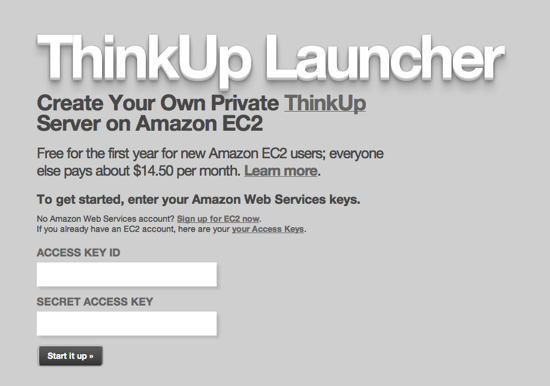
Finally, in December, a commercial service appeared that offered drop-dead simple ThinkUp hosting. We worked with PHP Fog, a Portland-based cloud hosting company, to support a one-click ThinkUp jumpstart. Here’s the screencast I made, showing off how to get up-and-running in seconds.
To help expand the reach of the app, I worked with Mule Design to figure out what ThinkUp does well, what it could do better, and incorporate those learnings to redesign the next version of ThinkUp. Elements of the redesign have already made their way into ThinkUp 1.0, and will guide later versions of the app.
Analysis. Whether it was making charts, building mashups, or crunching data, I spent quite a bit of effort trying to make sense out of the incredible amount of data being collected by ThinkUp.
I showed off the ThinkUp API with ThinkBack, an open-source mashup that extracted entities from your historical Twitter history to make a time machine of the people, places, and things in your past.
I analyzed Twitter reactions to 2011 and 2012 State of the Union speeches, as well as the White House’s Twitter Town Hall, releasing datasets for each. I even made my first, and only, linkbait infographic summing up the White House’s Year in Review on Twitter.
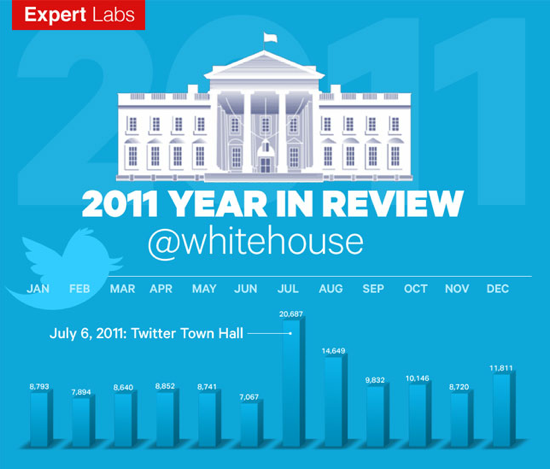
One of the biggest projects I created was the Federal Social Media Index, which used ThinkUp to gather activity from 125 federal agencies on Twitter, and try to measure their engagement for the questions they ask using some simple metrics. The response was great, showing how much interest there is for additional tools in that world.
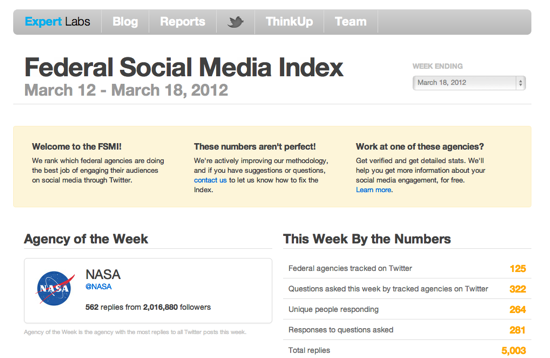
Over the last few weeks, I’ve adapted it to use the ThinkUp API and will be open-sourcing the results soon to use on your own projects.
Overall, working with Expert Labs was fascinating for me. I’d never worked with government before, and was able to work with motivated and passionate teams from the White House down to local city government. It was an eye-opening experience, and I learned a ton about cultivating an open-source community, the challenges facing state and federal government agencies, and distributing hosted software. Best of all, I was able to do it all while working with three friends I deeply respect: Gina Trapani, Anil Dash, and Clay Johnson.
The Future
Expert Labs may be ending, but ThinkUp is just getting started. It’ll continue to be free and open-source, and Gina and Anil are spinning ThinkUp off into a commercial entity, using the open-source base to create a new media property. You can read more about their plans on their Knight News Challenge application on Tumblr, which you should totally like and reblog. (The number of votes factors into the Knight Challenge judging!)
And me? I’ll be doing new stuff, like always. I’m still writing my weekly Wired column, working on Playfic, and thinking about big future projects.
I’ve started working on two unannounced projects simultaneously that I’m crazy excited about. Both have to do with this problem: how do you use technology to connect people together in new ways, and help people make a living doing what they love? It’s a running theme through everything I’ve ever worked on, and I’ll be writing much more about them soon.
For the first time in a very long time, I’m also open to hearing about new opportunities. If you’re working on anything along these lines and want help, get in touch!
Flashback Trojan Creators Scared of Xcode, But Not Norton Antivirus
On Wednesday, a Russian antivirus firm announced that over 600,000 Macs were infected with the Flashback trojan, exploiting a Java vulnerability to create the first significant malware infection in OS X history.
If you’re running a botnet, the goal is to avoid detection for as long as possible. Flashback took an interesting approach to hiding itself — if one of several popular antivirus or monitoring tools is detected, it immediately deletes itself. Merely installing a utility like Avast, Clam Antivirus, Little Snitch or HTTP Scoop was enough to protect you, even if you didn’t keep them running.
Funny enough, major commercial antivirus utilities like Norton Antivirus, McAfee VirusScan, and F-Secure weren’t included in the blacklist. It seems the Flashback authors aren’t afraid of the effectiveness of those utilities or, maybe, the technical expertise of their customers.
From the threat description:
On execution, the malware checks if the following path exists in the system:
/Library/Little Snitch
/Developer/Applications/Xcode.app/Contents/MacOS/Xcode
/Applications/VirusBarrier X6.app
/Applications/iAntiVirus/iAntiVirus.app
/Applications/avast!.app
/Applications/ClamXav.app
/Applications/HTTPScoop.app
/Applications/Packet Peeper.app
If any of these are found, the malware will skip the rest of its routine and proceed to delete itself.
Note the presence of Xcode, Apple’s IDE for Mac and iOS development. To a virus author, the presence of development tools like Xcode is a perfect indicator of a tech-savvy user… the kind of person most likely to detect your work.
If you want to stay safe, or see if you were infected, Macworld has the best roundup.
Crate-Digging Through YouTube
I love when I’m crate-digging through the weird part of YouTube and stumble on something truly amazing, seen only by a handful of other people. Just now, I was looking for the redneck bar scene from 48 Hrs. and found this:
It’s the opening titles for 48 Hours of Hallucinatory Sex (originally “48 Horas de Sexo Alucinante“), a 1987 trash/sexploitation film from Brazil. (Don’t worry, the clip’s safe for work.)
Everything about this video is amazing, from the face-melting porno synth to the Amstrad-like scrolling fonts. (You can see the blinking cursor!) With the VHS warble, it sounds like an unreleased track straight off of DJ Shadow’s Endtroducing… I couldn’t find any information about the soundtrack online, but would love to hear more.
The sequel to a 1985 movie called 24 Hours of Explicit Sex, the plot of 48 Hours is totally meta: a sex psychologist sees the original film and hires the original cast and crew to make her own. It’s like the ’80s porno version of The Human Centipede 2: Full Sequence, where a psychopath is inspired to recreate the events of The Human Centipede using the real-life actors from the film.
The last time I stumbled on anything this funky, it was this scene from low-budget indie comedy Apple Pie from 1976, that ends with this insane 15-minute-long choreographed dance sequence set on the streets of 1970s NYC. And the music? An improvised funk jam by Hall & Oates.
This happens to me every time I go to NYC.
Waiting for Molydeux: What the Web Could Learn from Indie Games
Over April Fool’s Day weekend, hundreds of independent game developers came together for What Would Molydeux?, a 48-hour gamejam celebrating the tweets of Peter Molydeux – the anonymous doppelgänger of Peter Molyneux, the legendary British game designer known for his grandiose visions for games as art.
For the last three years, @PeterMolydeux’s written hundreds of surreal game ideas on Twitter, satirizing the game industry and the high-minded aspirations of his real-world namesake. For example:
- Your loved one has turned into a snowman. Yet your body needs to be as hot as a oven on high heat to survive. What would you do?
- What if everyone in the world had an explosive telephone in their body? If you could find out their number you can detonate their phone?
- You are a small girl flying a talking kite. The kite seems to know about a upcoming major terrorist attack and floats towards clues.
Double Fine lead programmer Anna Kipnis was first to suggest a gamejam, in which each developer would build a game inspired by one of Molydeux’s tweets — in two days, start to finish. The idea spread quickly and, within days, local events were planned in more than 30 cities worldwide.
The end result: nearly 300 insane games of wildly varying quality from 900 participants, with more trickling in daily.
I’ve spent the last three days obsessively playing through dozens of these. So far, I’ve been an innocent man with psychopathic arms, a pigeon trying to save suicidal businessmen, a road manipulating emotional cars, and a bear that needs hugs to survive.
I’ve played games with unreliable narrators, games that hide the rules from you, games with emotional title screens, and games that use the pause button as a weapon.
It won’t be for everyone, and that’s totally okay. Indie games often won’t appeal to the Call of Duty crowd, just like most Taylor Swift fans won’t listen to Hüsker Dü. Good things happen when you stop worrying about what’s marketable, and just make something you believe in.Not every game works — they were made in 48 hours, after all — but it’s surprising how many do.
So much of what I love about the indie gaming scene is embodied in the MolyJam event. It’s daring, creative, silly, and not afraid to fail. More and more, I find myself drawn to this world, even though I’ve never made a game, and I think it all comes back to what I love about the web.
Rise of the Indie
Indie games are in the middle of a renaissance right now, a Cambrian explosion of creativity enabled by the internet. Digital distribution platforms including Steam and the App Store have lowered the barrier to entry for indies, while crowdfunding sites like Kickstarter have reduced the importance of traditional publishers for funding projects.
Combined with a litany of complaints about the mainstream gaming industry, from exploitative working hours to the lack of creative and financial control, talented game developers are increasingly choosing to strike out on their own.
It’s resulted in a cultural movement, with commercial blockbusters like Minecraft, Braid and Super Meat Boy coming from small teams of one or two people, with even smaller budgets.
In some ways, this is a return to form for the gaming industry. Many games from the 8-bit era were created by a single developer who handled all the code, art and sound.
As graphics and audio capabilities grew, so did the budgets and team size. Larger budgets meant more risk, which directly hampered experimentation. Like the film industry, the gaming industry’s seen its own shift towards sequels and licensed brands instead of innovative, original works. (All ten of last year’s best-selling games were sequels.)
The indie gaming movement is a direct challenge to the old way of doing things.
Finding the Niche
It seems like the web’s going through a similar cycle of growth, stagnation, and disintermediation.
Fortunately, web developers have never faced the same publishing and distribution middlemen that games, television, and film were forced to deal with. The only major gatekeepers now are the entrenched social networks.
It seems like the web’s losing some of its original experimental glow. There’s no shortage of people making awesome stuff online, but I can’t shake the feeling that much of the interesting creative coding is now happening elsewhere — mobile, gaming, physical computing. For new entrepreneurs, the landscape couldn’t be better. Lean startups composed of very small teams are bootstrapping or joining incubators like Y Combinator in lieu of traditional funding, allowing them more creative control while retaining greater ownership of their work.
But the ultimate goal of a startup is making money, not art. For me, the most exciting part of the indie gaming movement is that commerce still feels secondary to making something innovative, fun, and creatively interesting.
In the last few years, it seems like the web’s losing some of its original experimental glow as it’s matured. There’s no shortage of people making awesome stuff online, but I can’t shake the feeling that much of the interesting creative coding is now happening elsewhere — mobile, gaming, physical computing.
Part of this could be market forces; there could be less experimentation when lots of money is getting thrown around. Or maybe the web is just losing its appeal in a universe increasingly ruled by native apps.
Maybe, like the desktop metaphor, the web has served its purpose and it’s slowly being replaced by platforms that solve these problems more effectively. Bookmarks, location bars, URLs, extensions, and even the browser itself will be abstracted away, hidden from view for a better user experience, as most people flock to walled gardens on simplified tablets and mobile devices.
All of that may be true. But it feels like it’s set the stage for a new indie movement, focused on using the web as an expressive creative medium over a commercial one. The tools at our fingertips are incredible: WebGL, WebSockets, Node.js, browser geolocation, standardized audio and video, among many others. And it’s easier than ever to get your work in front of an audience who cares: the people who still love the quirky indie web and everything it stands for.
It won’t be for everyone, and that’s totally okay. Indie games often won’t appeal to the Call of Duty crowd, just like most Taylor Swift fans won’t listen to Hüsker Dü. Good things happen when you stop worrying about what’s marketable, and just make something you believe in.
We already have the tools, the distribution, and the audience. We even have our own gamejams; the tech world pioneered hack days for this kind of experimentation years ago.
Now we just need our own Peter Molydeux — someone with audacious, ridiculous ideas to inspire new vectors of awesomeness from the rest of us.
(Note: This was originally published in column on Wired.)
